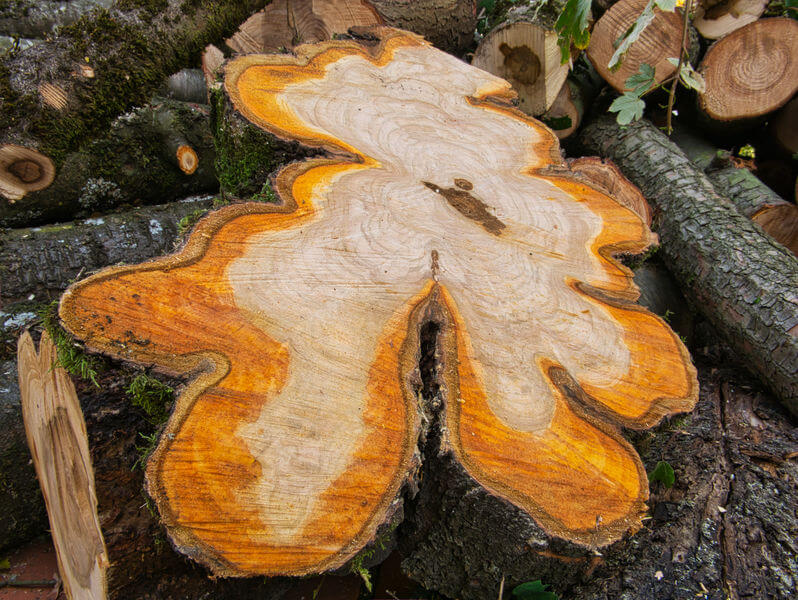So you’ve got yourself some cherry wood and you’re wondering how long it needs to season. Well, you’ve come to the right place! In this article, we’ll explore the answer to the burning question: how long does cherry wood need to season?
Seasoning wood is an essential step before using it for various projects like carpentry or cooking. But why is it important? Well, when wood is freshly cut, it contains a lot of moisture. Seasoning helps to remove that moisture, making the wood stronger, more stable, and less prone to warping or cracking.
But how long does it actually take to season cherry wood? That’s what we’re here to find out. Whether you’re a woodworking enthusiast or someone looking to use cherry wood for smoking meat, we’ve got all the information you need. Stick around to learn the ins and outs of cherry wood seasoning!
- Cut the cherry wood into manageable pieces.
- Stack the wood in a dry, well-ventilated area.
- Leave space between the pieces for air circulation.
- Cover the wood to protect it from rain or snow.
- Allow the wood to season for at least 6 to 12 months.
Properly seasoning cherry wood is essential for achieving the best results in your woodworking projects.

How Long Does Cherry Wood Need to Season?
Cherry wood is a popular choice in the world of woodworking due to its beautiful grain patterns and rich reddish-brown color. However, before it can be used for various projects, cherry wood needs to undergo a process called seasoning. Seasoning is the process of drying the wood to reduce its moisture content, ensuring better stability and durability. But how long does cherry wood need to season? In this article, we will explore the factors that affect the seasoning time for cherry wood and provide you with some helpful tips to ensure a successful seasoning process.
The Moisture Content of Cherry Wood
The moisture content of wood refers to the amount of water present within the wood fibers. Freshly cut cherry wood typically has a high moisture content, which can range between 60% to 80%. This high moisture content makes the wood prone to warping, shrinking, and cracking if it is used for any woodworking projects without proper seasoning.
The ideal moisture content for cherry wood used in woodworking projects is generally around 6% to 8%. Achieving this moisture content requires the wood to be properly seasoned. Seasoning cherry wood allows it to gradually lose its excess moisture until it reaches the desired moisture content for woodworking.
The Seasoning Process for Cherry Wood
There are two primary methods used for seasoning cherry wood: air drying and kiln drying. Air drying, also known as natural drying, involves stacking the wood in a well-ventilated area and allowing it to dry naturally over an extended period. This method takes longer but is considered to produce higher quality seasoned wood with fewer defects.
Kiln drying, on the other hand, involves using a kiln to artificially dry the wood. This method reduces the drying time significantly, making it a preferred choice for commercial woodworking operations. Kiln drying offers more control over the drying process, ensuring a more uniform moisture content throughout the wood.
Factors Affecting the Seasoning Time for Cherry Wood
The time required to season cherry wood can vary depending on several factors. Here are some key factors that affect the seasoning time for cherry wood:
– Thickness of the wood: Thicker pieces of cherry wood require a longer seasoning time compared to thinner pieces. This is because thicker wood takes longer for moisture to escape from the center of the wood.
– Environmental conditions: The climate and weather conditions play a significant role in the drying process of cherry wood. High humidity and colder temperatures slow down the drying process, while warm and dry conditions expedite it.
– Wood density: The density of cherry wood can impact the drying time. Denser wood, with tightly packed fibers, may take longer to dry compared to less dense wood.
– Proper airflow: Good air circulation is crucial for the proper seasoning of cherry wood. Stacking the wood with gaps between the pieces and ensuring adequate air movement can help shorten the drying time.
Tips for Successful Cherry Wood Seasoning
To ensure a successful seasoning process for cherry wood, consider the following tips:
1. Start with properly cut wood: Begin by cutting the cherry wood into boards, ensuring the ends are sealed to slow down moisture loss and minimize splitting.
2. Create a proper drying environment: Choose a well-ventilated area, preferably outdoors, with protection from direct sunlight and rain. Elevate the wood off the ground to allow for proper airflow beneath the stacks.
3. Sticker the wood: Use wooden spacers called stickers to create gaps between the stacked boards. This allows air to circulate between the boards, promoting even drying.
4. Monitor the moisture content: Regularly check the moisture content of the wood using a moisture meter. The wood is adequately seasoned when it reaches a moisture content of 6% to 8%.
5. Be patient: Seasoning cherry wood is a time-consuming process that can take anywhere from several months to a year or more, depending on the factors mentioned earlier. Avoid rushing the process to ensure optimal results.
Conclusion
Properly seasoning cherry wood is essential for achieving the best results in woodworking projects. The process may take some time and patience, but the end result is wood that is stable, durable, and ready to be used in various projects. By understanding the factors that affect the seasoning time for cherry wood and following the tips provided, you can ensure a successful seasoning process and enjoy the beauty and durability of cherry wood in your woodworking endeavors.
Key Takeaways: How Long Does Cherry Wood Need to Season?
- Cherry wood typically needs to season for around 6 to 9 months before it is ready for use.
- Seasoning involves allowing the wood to dry out naturally, reducing its moisture content.
- This process is important to prevent the wood from warping or cracking when used.
- Properly seasoned cherry wood will burn efficiently and produce less smoke when used as firewood.
- It’s essential to store the wood in a dry, well-ventilated area to promote faster drying.
Frequently Asked Questions
Are you wondering how long it takes for cherry wood to season? Look no further! We’ve gathered the most common questions people have about the seasoning process of cherry wood. Read on to find out everything you need to know!
1. Why is it important to season cherry wood before using it?
Seasoning cherry wood is crucial because it reduces the moisture content within the wood. Freshly cut cherry wood contains a significant amount of moisture, and if it’s used immediately, it can lead to problems like mold, warping, or even cracking. By seasoning the wood, you allow it to dry out gradually, making it more stable and suitable for woodworking projects.
During the seasoning process, the moisture in the wood evaporates, shrinking the cells and making the wood stronger. This will prevent any potential damage in the future, ensuring your cherry wood projects stand the test of time.
2. How long does cherry wood need to season?
The duration required to season cherry wood can vary depending on several factors. Generally, cherry wood needs to season for at least six months to a year. However, keep in mind that the specific drying time will depend on the thickness of the wood, the climate in your region, and the method you use for seasoning.
If you’re air drying the wood, it might take up to a year or even longer. On the other hand, using a kiln for drying can significantly reduce the drying time, possibly taking as little as a few weeks. It’s important to check the moisture content using a moisture meter to ensure it’s below 20% before using the wood in your projects.
3. What is the best method to season cherry wood?
One of the most common methods for seasoning cherry wood is air drying. To air dry cherry wood, you’ll need to cut it into planks and stack them neatly with spacers between the layers to allow for proper air circulation. Place the stacks in a dry, well-ventilated area, protected from rain and direct sunlight.
Another option is using a kiln, a controlled environment that accelerates the drying process. Kiln-drying cherry wood can be quicker and more efficient, as it removes moisture faster and more evenly. However, kiln-drying requires specialized equipment and knowledge, so it may not be feasible for everyone.
4. Can you use cherry wood before it’s fully seasoned?
While it’s not recommended, there are instances when you might need to use cherry wood before it’s fully seasoned. If you absolutely need to work with fresh cherry wood, make sure to seal the ends with a wood sealer to slow down the drying process and reduce the risk of cracking. Additionally, expect some degree of warping or movement as the wood continues to dry.
However, for the best results, it’s always recommended to allow cherry wood to fully season before using it in any woodworking projects. Taking the time to let the wood dry properly will lead to more stable and durable finished products.
5. How can you tell if cherry wood is fully seasoned?
When cherry wood is fully seasoned, it should have a moisture content of around 6-12%. One way to determine the moisture content is by using a moisture meter, a handy tool that measures the moisture levels within the wood. Make sure to check the moisture content in multiple spots and depths to ensure an accurate reading.
Additionally, fully seasoned cherry wood will have a lighter weight compared to freshly cut wood and will produce a resonant sound when tapped, rather than a dull thud. Lastly, the wood grain will appear uniform, indicating that the moisture has evenly evaporated. These visual and tactile cues can help determine if the cherry wood is ready for use in your woodworking projects.

Summary
Cherry wood needs to season for about 6 to 12 months before it is ready to use. During this time, it needs to be stored in a dry and well-ventilated area, away from moisture. Seasoning helps remove excess moisture and allows the wood to become stable and suitable for woodworking projects.
To properly season cherry wood, it is important to check its moisture content using a moisture meter. Aim for a moisture content of around 6-8% for indoor furniture projects. This process may take longer if the wood is thicker or if the humidity levels in the storage area are high. Patience is key when seasoning cherry wood, as rushing the process can result in warping or cracking. By following these guidelines, you can ensure that your cherry wood is properly seasoned and ready to be transformed into beautiful furniture or other projects.
